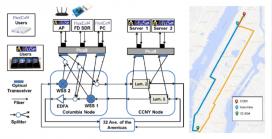New York City Gets Prototype of Smart-City Network that Can Handle Advanced Applications
A smart-city testbed in New York City, focused on network speeds needed for advanced applications, was developed by researchers supported by from Columbia University and the University of Arizona with support from the Center for Integrated Access Networks (CIAN), an NSF-funded Engineering Research Center (ERC) that is based at the University of Arizona.
Unlike many smart-city testbeds, the CIAN prototype in New York focuses on the network rather than the applications. The robust network would provide the necessary bandwidth and speed for testing the unique applications under consideration, such as tactile control and 3D sensors.
Many of those unique applications under consideration have latency and bandwidth requirements that cannot be met using today’s networks. Furthermore, the network must work seamlessly with computing and applications through software control. For this purpose, a software defined networking (SDN) platform was developed using programmable optical, wireless, and data-networking elements.
The first node was established with a cloud radio-access networking configuration to test full-duplex radio signals (FlexICoN) and radio multicasting (AMuSE). Experiments used signals sent across New York City and back to Columbia University. The optical platform developed for this testbed was further incorporated into the COSMOS platform, which was recently recognized among NSF platforms for its advanced wireless research. CIAN is a key partner in COSMOS, leading the development of its optical network.



